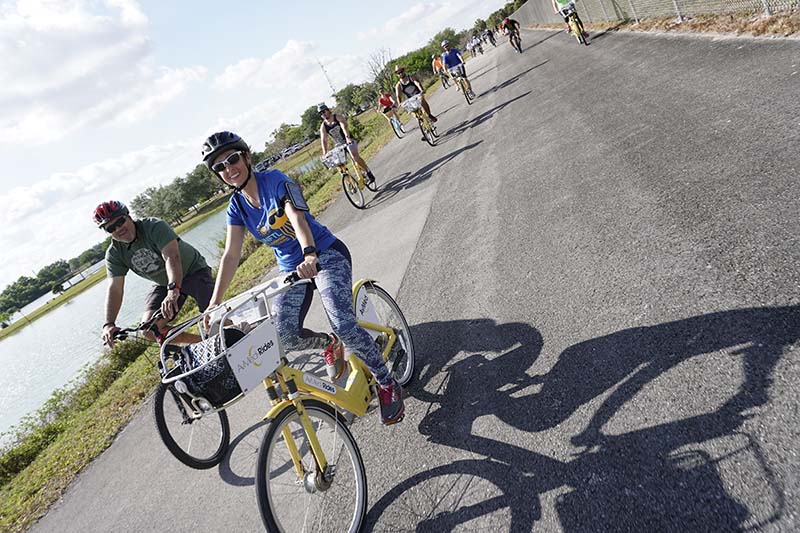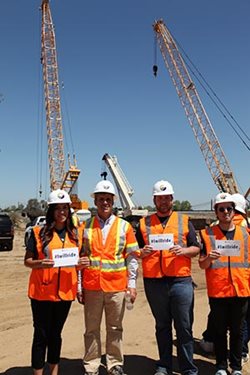Reaching the People
Taking an Innovative Approach to Public Engagement
 Broward Metropolitan Planning Organization regularly hosts "Let's Go Biking" events
Broward Metropolitan Planning Organization regularly hosts "Let's Go Biking" events
On a sunny April day about 200 cyclists of all ages spent the morning and early afternoon riding around Vista View Park in Davie, Florida. There were lessons on bicycle safety, helmet fittings and giveaways. The event, called “Let’s Go Biking,” sounds like one a cycling club might host, but it’s a regular program organized by the Broward Metropolitan Planning Organization (MPO) as part of its Complete Streets Initiative.
While the event encourages people to bike for their health and to consider cycling as a transportation alternative, it also gives the MPO an opportunity to introduce itself to members of the community who may not attend a traditional public meeting. The events are also used to showcase infrastructure improvements Broward MPO is planning or has completed. And last year, after attendees checked in at the registration table, they were encouraged to take a survey about their future transportation needs as part of the planning organization’s federally required long-range transportation plan update.
“We want to be in the community, and we want to be engaging with people,” said Erica Lychak, communications principal coordinator for Broward MPO. “This gives us a shared activity of sorts but the other thing that it does is it lets us say, ‘Hey, here’s what the MPO is actually doing.’”
The annual events are just one of many creative ways the planning organization is working to reach the public. And Broward MPO isn’t alone in these efforts. Metropolitan planning organizations and transportation providers across the country are turning away from reliance on traditional public meetings in favor of new, interesting, unorthodox and sometimes fun outreach techniques—special events, booths at fairs, pop-up kiosks, student advisory groups, community liaisons, graphic novels and more. The goals are the same—to ensure the public has an effective voice in how their tax dollars are invested. It also helps the public shape the delivery of programs and services. This issue of InTransition presents some of the innovative ways public agencies across the United States are engaging their communities.
Beyond Meetings
Traditionally, meetings have been used to gather public comment—envision a school gymnasium or large conference room with a micro-phone at the front and residents lined up to weigh in on a given topic. The problem is, unless the topic is a hot one—like closing a school—the meetings often attract disappointingly few residents, with many of those being the advocates and local gadflies who are seen and heard from very frequently. The end result is a lot of staff time and resources wasted for little public feedback.
Miriam Salerno, a senior public relations specialist and head of the Public Outreach and Engagement Team at the Alan M. Voorhees Transportation Center at Rutgers University, knows about the disappointment. Working with the NJTPA and a consortium of public and non-profit groups—called Together North Jersey—the Voorhees Transportation Center held traditional public meetings in counties across northern New Jersey in 2012 to gather input on a regional plan for sustainable development. While the meetings drew 30 to 40 people, organizers had hoped to attract much larger crowds.
“For the amount of money and the amount of time that went in, it really was just not a good return on the investment,” she said. “We started to think creatively about what might work better.”
The result was a joint project with NJTPA, the MPO for northern and central New Jersey, to find and implement creative public outreach approaches.
Salerno said one thing that all of the different outreach strategies her team researched have in common is how they view the public.
“What I learned was to always look at the public as subject matter experts in their field, and their field is life in the community that they live in,” she said. “If you keep that in mind, it changes the whole tone of the conversations where you really are actively listening to what they are saying.”
Salerno said it’s important to think of the audience when deciding what questions to ask and what format to ask them in.
The insights about innovative techniques were cataloged in an online tool (njtpa.org/engage) and became the basis for a specialized outreach plan for NJTPA’s regional transportation plan, Plan 2045: Connecting North Jersey. That effort sought to ensure that harder to reach groups—low-income residents, limited English speakers, young people and millennials—had a say in future transportation plans (see sidebar page 6). The online tool, Engage! A Public Involvement Resource, contains a searchable database of more than 150 outreach techniques and strategies. There are also tips and best practices, fact-sheets and reports summarizing the NJTPA’s focus group research and interviews with leading public outreach practitioners.
Focusing on the Public
Broward MPO has woven public engagement into everything it does, including rebranding its website and social media accounts from a focus on the organization, to the theme “Speak Up Broward,” to encourage the people in Broward County to talk about transportation.
“The philosophy behind not having it be Broward MPO, Broward MPO, Broward MPO, is really taking the focus off of our agency and putting the focus back on the public and what they have to say about it and that conversation and that dialogue,” said Anthea Thomas, Broward MPO’s public outreach coordinator. “At the end of the day the MPO isn’t really who we are, it’s what we do for the community.”
Lychak added that the change makes Broward MPO seem more approachable and less like a government agency, which can sometimes carry a stigma of being unresponsive or less trustworthy.
“It takes away the government label in a very good way,” she said.
They are also diligent about thinking about the way they present information. The agency works hard to eliminate jargon and present projects and plans in terms the general public will understand, Thomas said.
They spend a lot of time in the community, working with partner organizations at events and working with the school district to introduce students to transportation planning. They also have two informational booths, which they take to libraries, senior centers and community centers in an effort to promote projects and programs, but also to connect with harder to reach populations — low-income residents, people with disabilities, young people and senior citizens.
They developed an ambassador program to showcase the stories of commuters with disabilities who use public transportation. They shared stories of various riders during Americans with Disabilities Month, but plan to keep the program going.
“It was a way to show people the different challenges in a commute or the different triumphs in a commute,” Thomas said. “In South Florida it’s all about the car. We have so much suburban sprawl and it’s tough to get people on board with public transportation. … We just wanted to educate people about other experiences.”
The online posts also generated conversation, with some people sharing their own challenges on social media. In at least one case the MPO was able to connect someone who had to take three different buses to get to work with the transit providers, to see if they could come up with a better solution.
Community Involvement
When the MPO was working to build consensus on a particularly controversial project that had been stalled for decades—what to do with increasing traffic on the SW 10th Street corridor that connects Florida’s Turnpike and I-95—they created a Community Oversight and Advisory Team with representatives from homeowners associations in the area, to meet with Broward MPO staff and local officials.
The advisory team got a crash course on transportation planning and the role of an MPO, before being asked to weigh in on the project. Each team member was encouraged to take information back to their communities to raise awareness about the project and various alternatives being considered. After meeting for less than a year, the group was able to reach consensus on a preferred recommendation and Florida Department of Transportation is continuing to work with the group on the project, which has now moved on to the project development and environment phase.
Thomas said the advisory team could serve as a model for other projects where there is a controversial topic, or hard to reach populations because team members become trusted advocates who can explain the project to others.
“It’s something I would definitely recommend because at the end of the day, people who can’t make it to public meetings sometimes they’re not going to trust the government entity but they will trust someone in their neighborhood,” she said.
Building Momentum

Sometimes public outreach starts at the grassroots level. The formation of a student group at California State University-Bakerfield in support of the bullet train project, spurred the California High-Speed Rail Authority to develop the #iWillRide campaign, a social media and college group initiative that targets millennials and students. Now six colleges—mostly in California’s Central Valley region where the rail line is under construction—have student chapters helping to raise awareness about the project. And the campaign has reached more than 65,000 people through outreach and community events.
Todd Nguyen, a transportation planner and deputy project manager for California High-Speed Rail, said the initiative is more than a social media campaign. Members of the student chapters were invited to the rail line’s ground breaking in 2015. They’ve also taken tours of construction sites, set up informational tables at events to help raise awareness of the project and participated in a student symposium. The authority has also hosted job fairs and offers internships that have led to several full-time job opportunities for students after graduation, Nguyen said.
“It was really important for the California High Speed Rail Authority to focus on who our riders are for the next generation,” Nguyen said, noting that many of the students were too young to remember the push for high-speed rail when voters approved it in 2008.
The student groups not only help raise awareness about the project, but they also help start a dialogue with a key constituency—future riders—who are unlikely to attend a traditional public meeting. Nguyen said the authority has tapped into existing student organizations that have ties to transportation—college chapters of the American Planning Association or Institute of Transportation Engineers—to generate interest in local #iWillRide chapters.
There are already chapters at Fresno City College, Fresno State, San Jose State, and University of California, Merced in Central Valley and University of California, Berkeley in the Bay area. Nguyen said the goal is to develop more chapters in areas where the rail line is under construction as it moves to other parts of the state.
“We want them to be informed of what’s happening in their own home, the State of California, and we really love this feedback,” he said.
An Individualized Approach
While there are a lot of different ways to reach the public and target specific populations, Salerno said it’s important to keep in mind that there is no one size fits all approach to outreach. She said it’s important to develop an outreach plan for each project or initiative.
“Public engagement is so tailored that every time you do it you can’t just repeat what worked before,” she said.
Melissa Hayes is the managing editor of InTransition magazine.